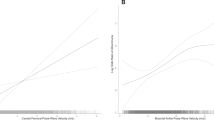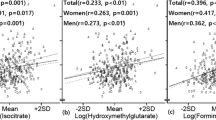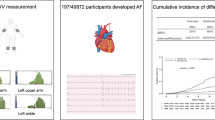Abstract
Brachial-ankle pulse wave velocity is a new measure of arterial stiffness. The clinical significance of brachial-ankle pulse wave velocity as a measure of early vascular damage remains unclear. We examined the hypothesis that higher brachial-ankle pulse wave velocity is associated with a much greater risk of albuminuria by employing a cohort of 718 never-treated hypertensive patients registered in a prospective study. The 718 patients consisted of 500 patients with normoalbuminuria (69.6%), 191 patients with microalbuminuria (26.6%) and 27 patients with macroalbuminuria (3.8%). The prevalence of microalbuminuria increased with a graded increase in brachial-ankle pulse wave velocity (17.6, 22.8, 28.2 and 39.6%, p<0.0001). The prevalence of macroalbuminuria remained constant until the third grade group of the brachial-ankle pulse wave velocity but increased significantly in the highest grade group compared with the lower grade groups (2.3, 3.2, 2.3, 9.9%, p<0.0001). Age, systolic and diastolic blood pressure, pulse pressure, heart rate, and fasting glucose concentration were also significantly increased with an increase in brachial-ankle pulse wave velocity (p<0.0001 for all). Multiple logistic regression analysis has shown that systolic blood pressure, fasting blood glucose, and brachial-ankle pulse wave velocity are significant risk factors for microalbuminuria. After adjusting for other risk factors, the odds ratio for an increase of 200 cm/s in brachial-ankle pulse wave velocity was 1.192 (95% confidence interval: 1.022–1.365; p<0.05). These data suggest that brachial-ankle pulse wave velocity is an independent risk factor for microalbuminuria and could be used as a marker for early vascular damage in never-treated hypertensive patients.
Similar content being viewed by others
Article PDF
References
Blankenhorn DH, Kramsch DM : Reversal of atherosis and sclerosis. The two components of atherosclerosis. Circulation 1989; 79: 1–7.
O'Rourke M : Mechanical principles in arterial disease. Hypertension 1995; 26: 2–9.
Labarrere CA, Zaloga GP : C-reactive protein: from innocent bystander to pivotal mediator of atherosclerosis. Am J Med 2004; 117: 499–507.
Benetos A, Waeber B, Izzo J, et al: Influence of age, risk factors, and cardiovascular and renal disease on arterial stiffness: clinical application. Am J Hypertens 2002; 15: 1101–1108.
London GM, Guerin AP, Pannier B, et al: Large artery structure and function in hypertension and end-stage renal disease. J Hypertens 1998; 16: 1931–1938.
van Popele NM, Grobbee DE, Bots ML, et al: Association between arterial stiffness and atherosclerosis: the Rotterdam Study. Stroke 2001; 32: 454–460.
Laurent S, Boutouyrie P, Asmar R, et al: Aortic stiffness is an independent predictor of all-cause and cardiovascular mortality in hypertensive patients. Hypertension 2001; 37: 1236–1241.
Blacher J, Guerin AP, Pannier B, et al: Impact of aortic stiffness on survival in end-stage renal disease. Circulation 1999; 99: 2434–2439.
Hirata K, Vlachopoulos C, Adji A, et al: Benefits from angiotensin-converting enzyme inhibitor ‘beyond blood pressure lowering’ beyond blood pressure or beyond the brachial artery? J Hypertens 2005; 23: 551–556.
Woodman RJ, Watts GF : Measurement and application of arterial stiffness in clinical research: focus on new methodologies and diabetes mellitus. Med Sci Monit 2003; 9: RA101–RA109.
Munakata M, Ito N, Nunokawa T, et al: Utility of automated brachial ankle pulse wave velocity measurements in hypertensive patients. Am J Hypertens 2003; 16: 653–657.
Yamashina A, Tomiyama H, Takeda K, et al: Validity, reproducibility, and clinical significance of noninvasive brachial-ankle pulse wave velocity measurement. Hypertens Res 2002; 25: 359–364.
Sugawara J, Hayashi T, Yokoi T, et al: Brachial-ankle pulse wave velocity: an index of central arterial stiffness? J Hum Hypertens 2005; 19: 401–406.
Munakata M, Nunokawa T, Tayama J, et al: Brachial-ankle pulse wave velocity as a novel measure of arterial stiffness: present evidences and perspectives. Curr Hypertens Rev 2005; 1: 223–234.
Matsui Y, Kario K, Ishikawa J, et al: Reproducibility of arterial stiffness indices (pulse wave velocity and augmentation index) simultaneously assessed by automated pulse wave analysis and their associated risk factors in essential hypertension. Hypertens Res 2004; 27: 851–857.
Munakata M, Sakuraba J, Tayama J, et al: The higher brachial-ankle pulse wave velocity is associated with more advanced carotid atherosclerosis in end-stage renal disease. Hypertens Res 2005; 28: 9–14.
Yokoyama H, Aoki T, Imahori M, et al: Subclinical atherosclerosis is increased in type 2 diabetic patients with microalbuminuria evaluated by intima-media thickness and pulse wave velocity. Kidney Int 2004; 66: 448–454.
Kobayashi K, Akishita M, Yu W, et al: Interrelationship between non-invasive measurements of atherosclerosis: flow-mediated dilation of brachial artery, carotid intima-media thickness and pulse wave velocity. Atherosclerosis 2004; 173: 13–18.
Yambe M, Tomiyama H, Hirayama Y, et al: Arterial stiffness as a possible risk factor for both atherosclerosis and diastolic heart failure. Hypertens Res 2004; 27: 625–631.
Okamura T, Moriyama Y, Kadowaki T, et al: Non-invasive measurement of brachial-ankle pulse wave velocity is associated with serum C-reactive protein but not with alpha-tocopherol in Japanese middle-aged male workers. Hypertens Res 2004; 27: 173–180.
Tomiyama H, Arai T, Koji Y, et al: The relationship between high-sensitive C-reactive protein and pulse wave velocity in healthy Japanese men. Atherosclerosis 2004; 174: 373–377.
Aso K, Miyata M, Kubo T, et al: Brachial-ankle pulse wave velocity is useful for evaluation of complications in type 2 diabetic patients. Hypertens Res 2003; 26: 807–813.
Yokoyama H, Hirasawa K, Aoki T, et al: Brachial-ankle pulse wave velocity measured automatically by oscillometric method is elevated in diabetic patients with incipient nephropathy. Diabet Med 2003; 20: 942–945.
Munakata M, Toyota T, Nunokawa T, et al: Arterial stiffness and renal damage in hypertension. J Jpn Soc Dial Ther 2004; 37: 205–207 ( in Japanese).
Tsioufis CP, Lambrou SG, Stefanadis CI, et al: Microalbuminuria is associated with abnormal thoracic aortic mechanics in essential hypertension. Am J Cardiol 2000; 86: 797–801.
Mule G, Cottone S, Vadala A, et al: Relationship between albumin excretion rate and aortic stiffness in untreated essential hypertensive patients. J Intrern Med 2004; 256: 22–29.
Kitahara T, Ono K, Tsuchida A, et al: Impact of brachial-ankle pulse wave velocity and ankle-brachial blood pressure index on mortality in hemodialysis patients. Am J Kid Dis 2005; 46: 688–696.
Rossing P, Hougaard P, Borch-Johnsen K, et al: Predictors or mortality in insulin dependent diabetes: 10 year observational follow up study. BMJ 1996; 313: 779–784.
Jager A, Kostense PJ, Ruhe HG, et al: Microalbuminuria and peripheral arterial disease and independent predictors of cardiovascular and all-cause mortality, especially among hypertensive subjects: five-year follow-up of the Hoorn Study. Arterioscler Thromb Vasc Biol 1999; 19: 617–624.
Damsgaard EM, Froland A, Jorgensen OD, et al: Microalbuminuria as predictor of increased mortality in elderly people. BMJ 1990; 300: 297–300.
Gerstein HC, Mann JF, Pogue J, et al: Prevalence and determinants of microalbuminuria in high-risk diabetic and non-diabetic patients in the Heart Outcomes Prevention Evaluation Study: the HOPE Study Investigators. Diabetes Care 2000; 23 ( Suppl 2): B35–B39.
Hillege HL, Fidler V, Diercks GF, et al, Prevention of Renal and Vascular End Stage Disease (PREVEND) Study Group: Urinary albumin excretion predicts cardiovascular and noncardiovascular mortality in general population. Circulation 2002; 106: 1777–1782.
Yuyun MF, Khaw KT, Luben R, et al: Microalbuminuria independently predicts all-cause mortality in a British population: the European Prospective Investigation into Cancer in Norfolk (EPIC-Norfolk) population study. Int J Epidemiol 2004; 33: 189–198.
Ibsen H, Olsen MH, Wachtell K, et al: Reduction in albuminuria translates to reduction in cardiovascular events in hypertensive patients. Hypertension 2005; 45: 198–202.
Roden J : Urinary albumin excretion-lowering the threshold of risk in hypertension. Hypertension 2005; 46: 19–20.
Kohara K, Tabara Y, Tachibana R, et al: Microalbuminuria and arterial stiffness in a general population: the Shimanami Health Promoting Program (J-SHIPP) study. Hypertens Res 2004; 27: 471–477.
Culleton BF, Larson MG, Parfrey PS, Kannel WB, Levy D : Proteinuria as a risk factor for cardiovascular disease and mortality in older people: a prospective study. Am J Med 2000; 109: 1–8.
Yamashina A, Tomiyama H, Arai T, et al: Brachial-ankle pulse wave velocity as a marker of atherosclerotic vascular damage and cardiovascular risk. Hypertens Res 2003; 26: 615–622.
Pannier B, Guerin AP, Marchais SJ, et al: Stiffness of capacitive and conduit arteries: prognostic significance for end-stage renal disease patients. Hypertension 2005; 45: 592–596.
Bakris G : Proteinuria; a link to undestanding chages in vascular compliance? Hypertension 2005; 46: 473–474.
Wilkinson IB, Franklin SS, Cockcroft JR : Nitric oxide and the regulation of large artery stiffness: from physiology to pharmacology. Hypertension 2004; 44: 112–116.
Pascual JM, Rodilla E, Gozalez C, et al: Long-term impact of systolic blood pressure and glycemia on the development of microalbuminuria in essential hypertension. Hypertension 2005; 45: 1125–1130.
Rosa TT, Palatini P : Clinical value of microalbuminuria in hypertension. J Hypertens 2000; 18: 645–654.
Barzilay JI, Peterson D, Cushman M, et al: The relationship of cardiovascular risk factors to microalbuminuria in older adults with or without diabetes mellitus or hypertension: the cardiovascular health study. Am J Kid Dis 2004; 44: 25–34.
Vogt L, Navis G, Koster J, et al: The angiotensin II receptor antagonist telmisartan reduces urinary albumin excretion in patients with isolated systolic hypertension: results of a randomized, double-blind, placebo-controlled trial. J Hypertens 2005; 23: 2055–2061.
Author information
Authors and Affiliations
Consortia
Corresponding author
Rights and permissions
About this article
Cite this article
Munakata, M., Nunokawa, T., Yoshinaga, K. et al. Brachial-Ankle Pulse Wave Velocity Is an Independent Risk Factor for Microalbuminuria in Patients with Essential Hypertension—A Japanese Trial on the Prognostic Implication of Pulse Wave Velocity (J-TOPP). Hypertens Res 29, 515–521 (2006). https://doi.org/10.1291/hypres.29.515
Received:
Accepted:
Issue date:
DOI: https://doi.org/10.1291/hypres.29.515
Keywords
This article is cited by
-
Comparison of brachial–ankle pulse wave velocity and carotid–femoral pulse wave velocity in association with albuminuria in a community of Beijing: a cross-sectional study
Journal of Human Hypertension (2022)
-
Carotid plaque score and intima media thickness as predictors of stroke and mortality in hypertensive patients
Hypertension Research (2013)
-
Effects of tumor type, degree of obesity, and chemotherapy regimen on chemotherapy dose intensity in obese cancer patients
Cancer Chemotherapy and Pharmacology (2013)
-
Prognostic significance of the brachial–ankle pulse wave velocity in patients with essential hypertension: final results of the J-TOPP study
Hypertension Research (2012)
-
Brachial-ankle pulse wave velocity is an independent predictor of incident hypertension in Japanese normotensive male subjects
Environmental Health and Preventive Medicine (2011)



